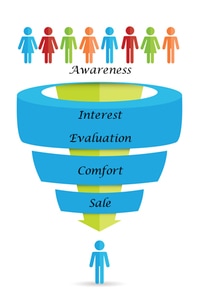 Marketing has two goals: the retention of existing clients and the acquisition of new clients. From existing clients you achieve stability and it is from new clients you achieve growth. When you design your marketing properly, both your existing clients and new clients first notice or are reminded of your presence, investigate your offerings and finally enter into conversation with you about the services or products you offer. At this stage you have an actionable lead and enter into the sales cycle. The process of drawing the potential client closer and closer to you, finally resulting in an actionable lead, is sometimes referred to as the “Marketing Funnel.” Indeed, all good marketing strategies are funnel-like in their conception, design and implementation:
Take a look any given marketing effort and you will see these principles are at the core as a framework for the effort. The tactical elements will vary from service to service or from retailer to retailer, but the underlying strategy and objectives are the same. Every tactic lined up to effect the marketing effort must be oriented by the same guiding principles: keep the client moving closer and closer to you. And this may well explain why you are not getting any leads from your travel agency website. If your website is designed like the vast majority of travel agency websites, it is very likely working against you rather than for you. It is highly likely your website’s design has a critical flaw, a totally flawed premise: you, the travel professional, sell travel. But the problem is, you don’t sell travel. Carnival Cruise Lines sells travel. Delta Vacations sells travel. Funjet sells travel. Expedia sells travel. You, however, are selling yourself. Put the wrong product in at the mouth of your marketing funnel and you get the wrong result. Worse yet, you assist your competition in getting leads. Meet the Marketing Trampoline and its little friend, Google. Most travel agency websites are designed by website companies not as marketing funnels but as marketing trampolines, catapulting your lead into a shopping frenzy on other websites. Consider how this happens, by following along and seeing if the results I’m indicating are not indeed accurate. What does the consumer do now? The Marketing Funnel, if were properly designed, would direct the consumer to enter into a conversation with you about their needs. However, people are sometimes reluctant to enter into a conversation, particularly when they have all of the information they need to attempt to satisfy their curiosity themselves. So, armed with all of the information YOU have just provided, the consumer BOUNCES (the trampoline) off of your site and does a Google search using the very information they just got from YOUR site. Do this yourself if you don’t believe me. Google “Viking River Cruises Rhine Getaway” Here is what the consumer, and you, will see: Here is what the consumer now does: Your objective was to draw the consumer closer to you to engage in conversation. My guess, however, is you will never speak to this consumer. They have bounced off of your site. You are now directly engaged in a price contest with Viking River Cruises themselves and dozens of other companies promising “the lowest price.” You will never have the opportunity to speak with them about what you do as a travel consultant, the protections your offer them, your consortia affiliations or your relationship with Viking River Cruises.
I’m not picking on Viking here, you can see the same result with any of these website search engines provided by most travel agency website companies. If you have one of these sites, please check out the results yourself across other suppliers in the search engine. Why? No doubt your suppliers are happy to have you promoting their product line. But your objective is not to promote suppliers, it is to earn a living selling your services. Something is out-of-whack here, as my mother used to say. The company that designed your website? They are getting paid by those same suppliers for the exposure on YOUR site. Their objective is to promote the suppliers who pay them to do so. Now if they are revenue sharing with you, if you are being paid to display the supplier logo, you may be happy with the arrangement. However, in most instances, this is not the case. In fact, you are paying the website company. Instead, the website company spends a great deal of time trying to convince you that supplier content is necessary, in fact supplier content is the vast majority or even the only content they provide. So What’s A Travel Agency to do? Let’s start by selling the right product: You. Then, let’s properly design the Marketing Funnel. Your website should promote you and your staff, your consortia connections, your experience, your satisfied customers and why all of this benefits the consumer. If you have travel specials, those specials should be OPAQUE, meaning the consumer must speak with you to obtain all of the information they need to book. Once they engage with you they are truly in the Marketing Funnel and you can properly evaluate their needs. Here is an earlier article on the topic. Conclusion Far too many travel agencies inadvertently end up bouncing their leads off of their website because the site is not designed on Marketing Funnel principles. Correct the situation by focusing on all of the ways you benefit your clients, therefore selling yourself rather than acting like a seller of travel. Share the knowledge
0 Comments
Your comment will be posted after it is approved.
Leave a Reply. |
AuthorWrite something about yourself. No need to be fancy, just an overview. Archives
August 2023
Categories
All
|
